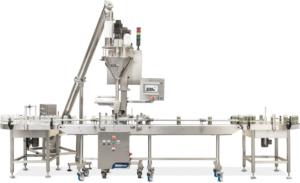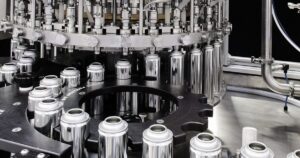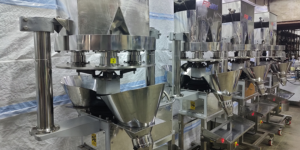Comprehending a Powdered Milk Filling and Packaging Machine
A powdered milk filling and packaging machine is an important device in the dairy industry. It helps to automate the tasks involved in filling powders into packages. These devices have precision fillers, sterile designs, as well as other features that make them efficient. There are different types of these machines such as auger filling machines, vacuum packers, rotary fillers, etc., which can be used depending on production needs.
During this process there are steps taken such as feeding, filling, sealing labeling inspection, and packaging so that milk powder may be accurately packaged in a sanitary manner. Some of the advantages include increased efficiency; better accuracy; improved hygiene; longer shelf life for products packed through it; ability to handle containers of different sizes and formats easily among others.
Moreover they find their use not only within dairy but also food processing plants where nutritional supplements or pharmaceuticals along with cosmetic industries could benefit from them greatly considering how many customer reviews/ratings serve as indicators concerning performance reliability when selecting one over another should future trends towards smart manufacturing sustainable packaging arise robots designed specifically for clean labeling which will help keep up with changing consumer needs while remaining competitive enough against other manufacturers within this sector.
What To Look For In A Milk Powder Filling And Packing Machine
Precision Filling: Ensure that your machine has advanced weighing systems and servo-driven mechanisms for the accurate filling of containers with milk powder.
Hygienic Design: Choose a model made from food-grade materials having smooth surfaces that can be easily cleaned without causing contamination.
Versatility: The equipment should be able to accommodate different shapes/sizes of cans or bottles thus meeting various production requirements.
Automation Features: Look out for automatic feeders/fillers/sealers/labelers to reduce human intervention during operation thereby streamlining processes within the shortest time possible.
Quality Control Systems: Machines having built-in inspection systems can detect variations in fill levels or packaging thus ensuring consistent quality.
Customization Options: Some machines allow you to adjust filling volumes, packaging formats as well sealing methods to suit changing needs.
Types Of Milk Powder Filling And Packaging Machines
Auger Filling Machines: These use screw-type augers that accurately measure and dispense powder into containers. They can be used for various powders such as coffee or milk etc., but work best with granules.

Vacuum Packing Machines: These utilize vacuum technology which sucks out air from bags/pouches thereby creating an oxygen-free environment around packed products preventing oxidation/microbial growth hence prolonging shelf life especially where moisture content is high like in powdered foodstuffs.

Rotary Filling Machines: These have rotating disc indexes that assist in filling powder canisters at higher speeds.

Volumetric Filling Machines: These measure volumes using a piston or gear pump which is more suitable when dealing with liquids having different viscosities than solids like powders etc., so they may not work well if used on this type of material.

Automatic Bagging Machines: Designed to fill pre-formed bags with milk powder, these are convenient and efficient for packaging large quantities of products.

Filling Process
The process begins by supplying the machine with milk powder either through a conveyor belt system or a hopper.
Then it measures the required amount of milk powder accurately before dispensing them into containers or packages.
Afterward, depending on what type of machine you are using; heat seals and zipper closures among others can be used to seal off the containers.
Upon completion, labels containing regulatory information about the product (e.g. batch number) may also be applied to its surface if necessary.
Automated systems check for proper filling as well as sealing while rejecting any defective products during an inspection stage.
Once filled & sealed batches are made ready for shipment while others may need further processing before distribution.
Benefits Of Milk Powder Filling And Packing Machines
Increased Efficiency: Automation helps reduce manual labor required thus speeding up production rates thereby increasing overall efficiency.
Enhanced Accuracy: These fillers have precision mechanisms that ensure consistency in weights which reduces give improves profitability.
Better Cleanliness: Cleanability and hygienic design prevent contamination by complying with the food regulations and ensuring product safety.
Longer Shelf-life: The milk powder is protected from moisture, oxygen, and light through vacuum packing and other sealing methods, thus extending its shelf-life as well as preserving its quality.
Flexibility: Machines that can handle different sizes of containers and packaging formats allow for versatility in meeting market needs amidst product differentiation.
Uses
Below are some of the industries where milk powder filling and packing machines find application;
Dairy Industry: Packaging milk powder for sale in retail or supplying to food processing companies in bulk.
Food Processing: Adding milk powder into bakery products’ recipes such as confectioneries, beverages, and ready-to-eat meals.
Nutritional Supplements: Packaging protein shakes containing powdered milk; meal replacements with powdered milk or dietary supplements made from it.
Pharmaceutical Industry: Utilizing milk powder during the formulation process when making capsules, tablets, or suspensions among other pharmaceutical formulations
Cosmetic Industry: This industry uses milk powder due to its moisture-retaining capabilities thus suitable for making face masks creams lotions etcetera which are applied on the skin externally to keep them hydrated all day long.
Ratings & Reviews
Milk Powder Filling And Packing Machine performance as well as reliability can be determined through customer ratings together with feedback. Among the things that should be considered include the accuracy of the machine; durability; ease of maintenance; and after-sale support among others. Certification like ISO standards or FDA compliance shows adherence to quality standards besides safety measures taken.
Prospects
Automation, and digitalization coupled with sustainability represent what lies ahead for milk powder filling machines. These include but not limited to ;
Smart Manufacturing: Using Internet things (IoT) technology will enable real-time monitoring thereby leading to predictive maintenance based on data analysis-driven decision-making processes during production cycle time reduction will also achieved here through this method because it leads to better utilization efficiency within the system.
Sustainable Packaging: To reduce environmental pollution caused by packaging materials used across different industries today companies should adopt more eco-friendly approaches towards this issue such as using bio-degradable packing containers that can be reused several times over before finally recycling them thus ensuring minimum wastage while at the same time meeting consumer demand for green products which are in line with their preference.
Customization: Machines that have modules can easily carry out various operations without necessarily changing entire modules thereby reducing downtime during the manufacturing process as well as being able to meet new market requirements quickly.
Robotics: Milk powder plant manufacturers are expected to increase the applicability of robotic systems for handling, filling, and packaging operations. This will lead to high-speed accuracy levels achieved during these stages since robots do not get fatigued like human beings do also they are capable of maintaining sterility throughout all contact points within their working environment hence enhancing product quality control measures taken by machines themselves rather than than relying on people who might make mistakes due tiredness or lack concentration etcetera.
Clean Labeling: As more consumers continue demanding clean label products there has been a need to improve labeling designs used so far because some of them may not fully communicate the transparency and authenticity information required about a given item.
